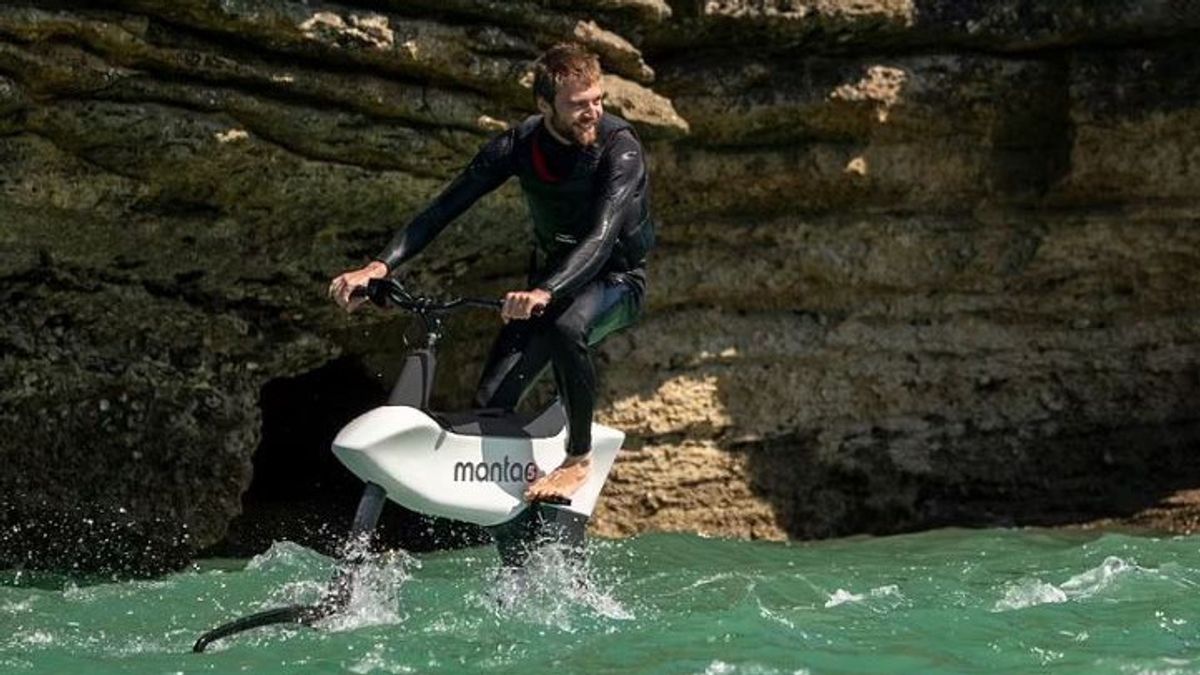JAKARTA A recent innovation about electric bikes has slid. This electric bike can be driven on water at a speed of 12.4 miles per hour (20 km/hour). This bike sells for about US$9,000 (138.8 million).
A bicycle called Hydrofoiler SL3 is produced by a company based in New Zealand, Manta5. The company also created the world's first hydrofoil bicycle, Hydrofoiler XE-1, in 2017.
This bike is described as 'half a bicycle, half an airplane'. Because the Hydrofoillar bike works with the driver pedaling to turn the propeller around the back, which is coupled with an electric motor to help get the next speed.
Foiling in Spain 🇪🇸 #castelldefels #spain #hydrofoils #bikeonwater pic.twitter.com/IpePDMMZaH
— Manta5 (@Manta5_NZ) August 14, 2021
After traveling fast enough, the bicycle's hydrofoil 'wing' at the front and back caused it to rise and fly across the surface of the water.
The SL3 version, the second generation, also has a 'only thrust' driving mode that doesn't require an initial assessment, making it a viable and more environmentally friendly alternative to engine-powered boats like jet skis.
The maker claims that this new feature, as well as other aspects of its design, allows motorists to learn to use it in just 40 minutes. It previously took more than two hours to learn in the original XE-1 version.
Having no hull or pontoon is a welcome exchange. Just like improving your skills on land bikes, it encourages learning and improvement, and ultimately to love every session," said Mark Robotham, CEO of Manta5.
Wet and wet when starting out is a fun part. Usually with SL3 it takes less than an hour to move from a beginner to a confident driver," he said, as quoted by the Daily Mail.
SL3 is made of carbon fiber and aluminum used in the aircraft industry which makes it quite light. Even very light to be carried into the water without trailers.
The modular design facilitates storage, but can also be assembled without tools, while on the riverbank.
When assembled, the length is 7.2 feet (2.2 meters), the width is 6.5 feet (two meters), and the height is 4.5 feet (1.4 meters), and the weight is up to 88 lbs (40 kg) depending on the type of foil and the battery pack installed.
Sasis and foil keep the bike flying upright even when it's quiet, but when it's time to take off again, the thrust can be activated or the driver can pedal manually.
The bike is powered by an electric motor of 2,500 Watts, and has ten levels of assistance available to generate speeds beside the pedal power, which can be used by simply pressing one finger.
The highest speed is 12.4 miles per hour (20 kph), this bike is designed to travel at a speed of seven miles per hour (11 kph) and has a minimum speed of four miles per hour (six kph).
There are three available models - SL3, SL3+, and SL3 Pro - in which the base model has a lithium-ion 600 fire battery with a charging time of three hours, and the other two have a battery pack of 1,000 liters with a charging time of five hours.
All models have a total travel time of 4.5 hours, which designers say is the longest travel duration of e-foiling products on the market today.
This bike comes with a performance-oriented carbon fiber back foil, which can be exchanged for heavier but more beginner-friendly aluminum foils.
There are a number of safety features, such as double-waterproof protective layers surrounding the battery, and sheaths covering the propellers.
The large screen shows important metrics such as thrust levels and battery levels as well as alerts, and the tilt sensor cuts power straight into the propeller as soon as it detects the bike is falling.
Driving a Hydrofoiler bike is described by manufacturers as a'real experience free of lanes and traffic' that provides'sensory flying above the surface of the water at speed'.
It can be done in salt water or freshwater. It can even be done for everyone who has the ability and knows how to swim and ride a bicycle.
Bicycles can handle small waves and overhauled waters, and claim to be able to 'cut' through tougher conditions than conventional stand-up rowing boards, kayaks, and most private boats.
They can sail along the waters with a minimum depth of three feet (one meter), but it takes at least seven feet (two meters) of water to launch.
The first generation of XE-1 collected many water cycling enthusiasts who enjoyed the sensation of flying over the waves, as well as the lack of noise and emissions generated while doing so.
Its popularity has provided the Manta5 team's dream that their product created a new sport category.
I want this bike to be more than just a recreational product - I want to be a sports product. If you can compete then it's competitive, and if it's competitive then one day it can be an Olympic sport," said Manta5 founder and director Guy Howard-Willis, to the Daily Mail.
There's a group of super hardcore users out there who do some amazing things. We see social clubs and sports organizations formed, long-distance channel crossings and record experiences on water that have to be on the list of buckets for passionate cyclists," said Louis Wilmas, Manta5 Marketing Manager.
Unfortunately, this bike is only available to distributors registered in Europe and the US at a price of between 7,000 and 9.000 US dollars, and there should be stock available for the summer of 2023.
The English, Chinese, Japanese, Arabic, and French versions are automatically generated by the AI. So there may still be inaccuracies in translating, please always see Indonesian as our main language. (system supported by DigitalSiber.id)













